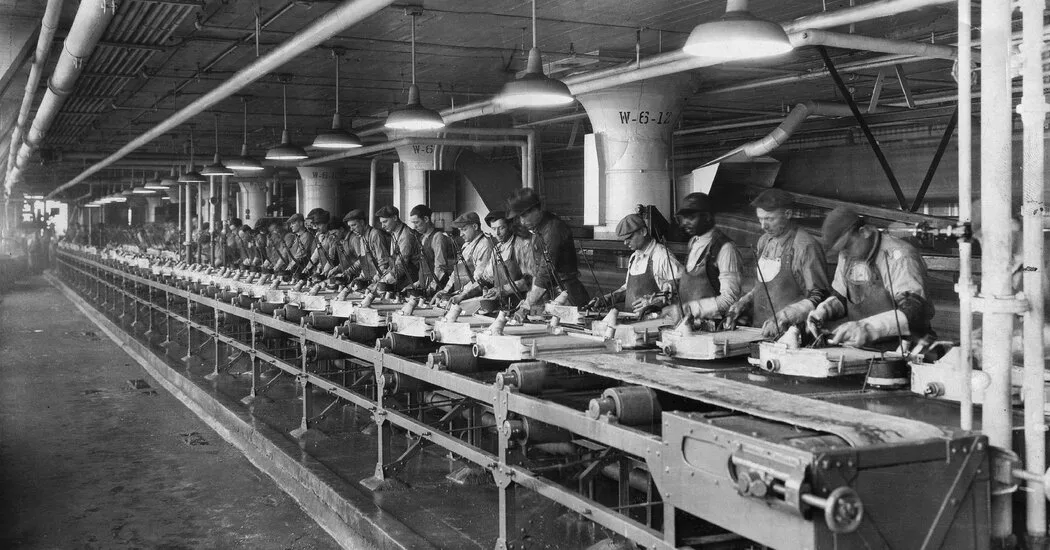
As autoworkers strike across the country, “Hillbilly Highway” and “Black Folk” offer two views of the search for a better life by working-class migrants in the middle of the 20th century.
HILLBILLY HIGHWAY: The Transappalachian Migration and the Making of a White Working Class, by Max Fraser
BLACK FOLK: The Roots of the Black Working Class, by Blair LM Kelley
Between 1900 and 1970, millions of Americans left the South for the North, West and Midwest. Max Fraser’s “Hillbilly Highway” traces the movement of about eight million of them, poor whites from the “Upper South” — states such as Arkansas, Tennessee, Kentucky — to industrial parts of the Midwest, cities such as Detroit, Cincinnati and Chicago. In “Black Folk,” Blair LM Kelley ties the exodus of another six million or so to a moving memoir of Black family migration, as well as to the wider sweep of time from slavery to the present. Together, these two migrations have helped shape two sides of our current perilous political moment.
Fraser, a scholar of labor history at the University of Miami, corrects several misconceptions. The usual view is that Southern Black people moved north during the first half of the 20th century, but Southern whites stayed put or went west when the Dust Bowl came in the 1930s. Yet many poor white migrants left debt-burdened farms, dead-end jobs and shuttered mills and mines, and ventured north on the “hillbilly highway” to settle in poor white ghettos such as Chicago’s Uptown, Muncie’s Shedtown and Dayton’s East End. There, like Black migrants, most found better lives than those they left behind.
Fraser also challenges writers who blame poor white Southerners for the rise of the anti-union right in the North. “Transappalachian migrants were early and eager supporters of Midwestern industrial unions,” Fraser notes, “in both radical hotbeds like Detroit and provincial outposts like Muncie.” They initiated work stoppages and slowdowns with and without union leadership.
And the transplanted hillbilly did not always vote conservative. When the Alabama governor George Wallace, an arch-segregationist, ran for president in 1968, only 6 percent of Chicago’s hillbilly Uptown neighborhood voted for him — a much lower proportion than the citywide average of 12 percent or the second- and third-generation European immigrant turnout of 17 percent. White blue-collar workers have since moved farther to the right, Fraser says, but hillbillies were no more or less likely to do so than other groups of white voters.
Blair LM Kelley’s “Black Folk” also has a bone to pick. When we think of “the American working class,” we think of whites, she notes. But much of that class is Black, and, compared with white laborers, a higher proportion of all Black people are part of it. Kelley, a professor of Southern studies at the University of North Carolina and the author of “Right to Ride: Streetcar Boycotts and African American Citizenship,” tells the poignant story of her grandfather John Dee, the son of a Georgia sharecropper.
Seated in a wagon with his four siblings and the family’s belongings, Dee left behind a familiar place, a can’t-get-ahead life and a mountain of debt. The family landed in North Carolina. Dee married in 1938 and pressed on to Philadelphia, where he sought work as a carpenter and his wife, Brunell, a high school graduate — rare for rural Southerners of any race at the time — aspired to an office job.
But while the North offered Black migrants freedom to vote and a far lower risk of lynching, it didn’t offer a fair crack at the factory or clerical jobs on offer to white workers. Brunell, unable to find office work, earned money as a housekeeper.
What Black migrants badly needed was access to well-paying jobs and to real union support, and for the most part, until the 1960s, both were denied to them. Dee did manage to join a local branch of the United Brotherhood of Carpenters, but found himself assigned to jobs in areas hostile to Black workers. Other Black workers were barred entirely from white-dominated unions; the 1918 charter of the Order of Sleeping Car Conductors specified that workers should be white.
As Kelley shows, many Black workers formed their own unions. In 1905, a washerwoman’s union in Richmond, Va., boycotted streetcars with segregated seating, bankrupting the company. In the 1930s and ’40s, A. Philip Randolph won better pay and hours for Black workers through his Brotherhood of Sleeping Car Porters and pushed the Franklin D. Roosevelt administration to desegregate all federal jobs.
Both white and Black migrants were used by Northern business interests toward their own ends. In the 1910s and ’20s, Goodyear Tire and Rubber Company in Akron, Ohio, sent recruiters into Appalachia to urge poor white people to move north to nonexistent jobs. “They were laying off men instead of hiring them,” one migrant reported. With a labor surplus, the company could undercut union activism, at least for a time, and spark antagonism between new migrants and white old-timers, who accused hillbillies of stealing jobs and undermining wages.
Some corporations also actively recruited Southern Black workers to break Northern white strikes, a fact missing from both books. In the nationwide steel strike of 1919, as the historian Stephen H. Norwood has written, steel companies recruited 30,000 to 40,000 Black workers, including thousands of recent Southern migrants in Chicago, to undermine the steelworker unions. And what about those unions? Were such unions the same ones that Fraser’s poor white migrants could join but from which Kelley’s Black migrants were barred? Fraser does not discount the possibility.
By 1940, nearly 11 percent of Southern-born white people and more than 15 percent of Southern-born Black people had left the South. Though studded with obstacles, the migration of Black people out of the South infused Northern cities such as Chicago, Philadelphia and New York with energy and talent, helped to galvanize the civil rights movement and created solid support for the modern Democratic Party.
As for the migration of white people from the Upper South to the Midwest, Fraser suggests that at least some hillbillies brought union activism and left-leaning votes with them when they traveled north, but his story ends around 1970. In “The Americanization of Dixie” (1974), the journalist John Egerton, generalizing about whites from all over the South, argued that white migration helped “Southernize” the North. More recently, a group of American economists has argued that “the Southern white diaspora played an important role in shaping” the modern conservative constituencies that gave us the presidency of Donald Trump.
Of course, much depended on what Southern white migrants did after they came north. If they become highly educated or live in a city, and happen to be young (say, the migrant’s children), they’re more likely to be liberal. But, as political scientists such as Katherine Cramer point out, the ones who stay on the farm often vote Republican because they strongly resent an “urban elite” that they feel both ignores and controls them.
According to a revealing 2020 Pew poll, 45 percent of Americans have stopped talking about politics with someone because of something their interlocutor said — 45 percent of conservative Republicans and 60 percent of liberal Democrats say they’ve done this. White people are more likely to cut off conversation than Black people: 50 percent versus 37 percent.
The 2024 election cycle has barely begun, and Joe Biden and Donald Trump have already made their way to Detroit to court working-class voters on the picket line. Some foresee a replay of the North-South civil war, with Donald Trump playing to the Southernization of the North and Joe Biden to the Northernization of the South. Race is again central, and we’re having a hard time talking about it. The very human stories in these two books could be just the thing to break the ice.


